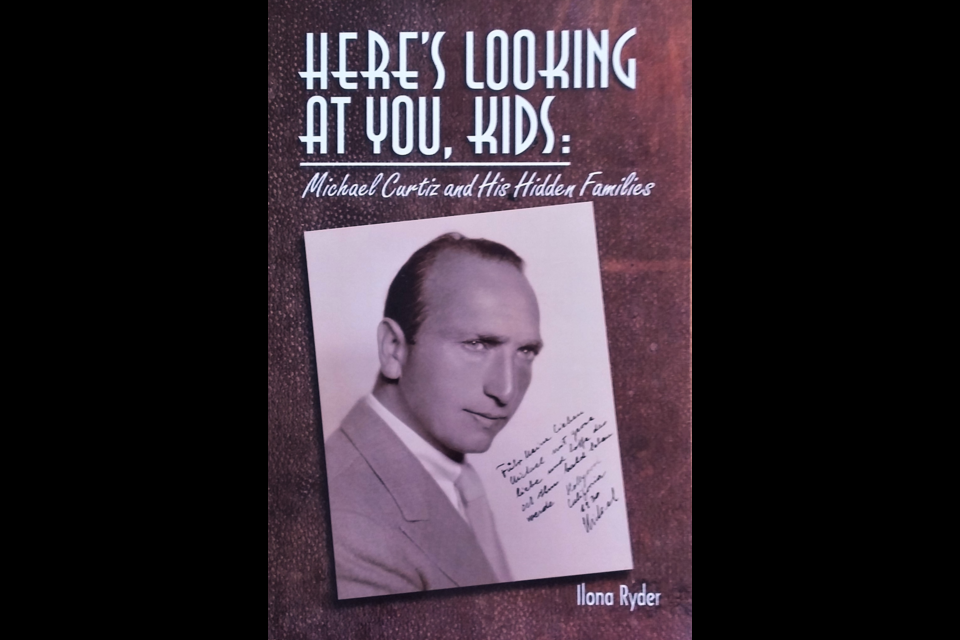DETAILS
Here’s Looking at You, Kids: Michael Curtiz and his Hidden Families
By Ilona Ryder
254 pages
$20
Self-published
Michael Curtiz ... the name might escape you, but he told you that you’ll always have Paris. You don’t have to be a film buff to recognize his name or the works he brought forth into the world. The Budapest-born director was responsible for a good number of popular Hollywood films in its Golden Age (We’re No Angels, John Wayne’s The Comancheros, and The Adventures of Robin Hood) plus numerous classics including Angels with Dirty Faces, Mildred Pierce, Yankee Doodle Dandy, and the holiday staple White Christmas.
Oh yeah, and a little film called Casablanca, arguably one of if not the greatest films of all time.
All told, Curtiz brought more than 175 cinematic babies to life. Accomplished though he was, Curtiz also had a complicated personal life with three marriages and even more real babies were the product of them. One local author is now focusing the camera on the director’s personal life for the big reveal: he had a lot of children in his hidden families, his granddaughter Ilona Ryder says, though it wasn’t until he passed away in 1962 that her family tree research started to take root.
“I was about 14 then, I think, when I first really thought about him and his career. I knew the family story. Curtiz's son had married my mom and then they had me in 1947. That news came on the radio. I probably forgot it fairly quickly. I was 14; my life went on. Not until I was in my 40s did I really start to think about him and what it all meant. I had no idea up until I started doing more research that there were other families. I didn't know anything about his private life.”
She was working at Grant MacEwan Community College in the mid-1990s when her colleagues prompted her to probe further into her genealogy. She started with her father – one of Curtiz’s sons – who had long been in the United States as an artist living in San Francisco. The early days of the internet opened a lot of doors to history.
“He had a website and on that website, there was a guest book, and I read through that. Somebody else who was related to Curtiz had written in that guestbook. That's how I started finding other family. I discovered that Curtiz had other children in Vienna before he came to the U.S., and that there were families from that. These were my aunts and uncles and cousins.”
Coincidentally, the first new relative she discovered was a cousin, another of Curtiz’s grandchildren, who also lived in Edmonton. Soon after, another cousin appeared in California and this one knew more about the family. This helped Ryder fill in more pieces of a bigger puzzle and soon, her 20-year biographical odyssey was on its way.
“Between that and starting to do more research, I started gathering families. I started gathering information about his work and creating a chronology: who was doing what, when, where they all come from, and all that.”
The result is Here’s Looking at You, Kids: Michael Curtiz and his Hidden Families, a book that fills in important gaps in the important director’s life. When she started the project, no biography had yet been written about his life though there had long been reports of Curtiz’s infidelities. When author James Robertson published The Casablanca Man, a focused look at the director’s filmography, he said that nothing would ever be known about Curtiz’s private life unless a family member came forward.
This is that book.
Here’s Looking at You, Kids is an exhaustive behind the scenes looks at the man behind the scenes of some of cinema’s great masterpieces. What Robertson said couldn’t be more true. Curtiz’s private life was really private because, as Ryder puts it, “he kept a lid on it because he messed around a lot.”
“There was a lot of gossip but he kept the lid on that as much as possible.”
Ryder, now in her 70s, is an eager member of St. Albert Volkssport and an even more enthusiastic member of the "published writers’ club." This daunting project is lovingly presented not as an exposé but as a tribute to the man himself, of course, but as a celebration to the larger Curtiz family that previously has not received its due. This book bridges the many gaps between relatives separated by continents and by circumstance. It’s basically a family album with a famous face at the head of the table.
For cineastes, it offers a lot of missing pieces to his private life, some of which might even shed some light on his filmmaking choices.
"Some scholars may want to make some connections between how he treated certain characters in some of his films, depending on what was going on in his private life. That's certainly why it would be good to get it into the hands of some film scholars who might be interested in that. Casablanca... it's always going to be there. We’ll always have Casablanca."
The author avoids doing any disservice to the cinematic artiste, sticking true to the facts she has painstakingly researched. After all, this is her family.
“That's one of the most wonderful things about this. I met a lot of people and made a lot of connections with these cousins, one from New Zealand who came to visit and people in Europe and then even Curtiz’s first daughter.”
Ryder’s book is available at Audreys Bookstore. On May 22, she’ll be hosting a launch and book signing at the Beaumont Library from 6 to 8 p.m.




